
Your Comprehensive Guide to Custom Size Mattresses in the UK
Share
Introduction
In today's diverse world of interior design and unique living spaces, one size certainly doesn't fit all. Be it loft conversions with quirky angles, antique bed frames inherited from generations past, or simply the quest for a mattress that's 'just right' for one's personal comfort — the need for custom solutions in bedding has never been more evident. As the traditional rectangle loses its one-size-fits-all appeal, bespoke mattresses tailored to specific needs are rapidly gaining traction, especially in the UK.
From the plush embrace of memory foam to the resilient support of traditional foam, the choices are vast. And it's not just about the mattress; custom-sized toppers are also entering the scene, offering both protection and an added layer of luxury. Whether you're new to the world of custom mattresses or looking to refine your knowledge, our comprehensive guide promises insights, tips, and a pathway to the perfect night's sleep.
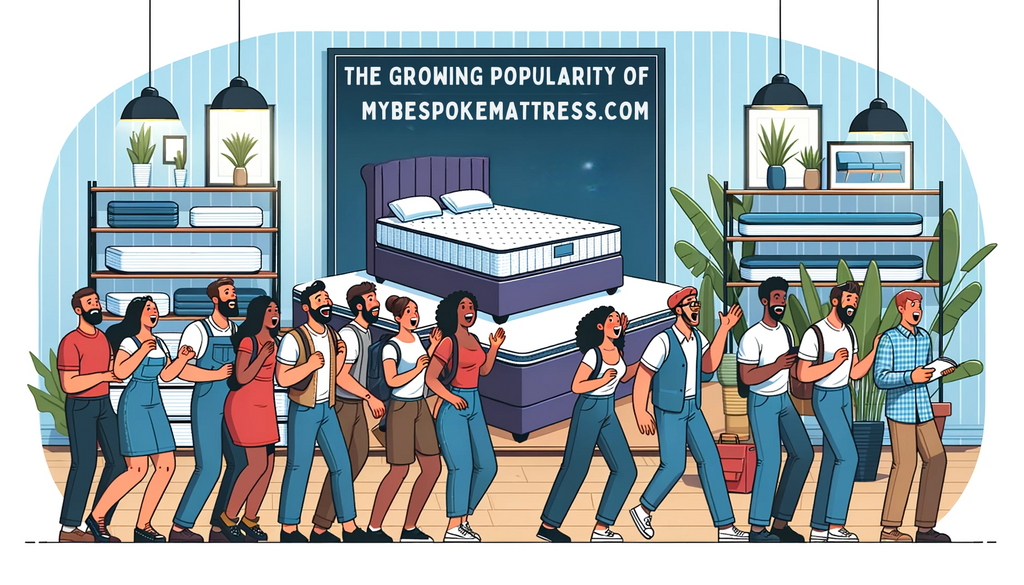
Table of Contents:
- The Growing Popularity of Custom Size Mattresses
- Memory Foam vs. Regular Foam: Which Custom Foam is Right for You?
- Delving into Custom Size Mattress Toppers
- A Step-by-Step Guide to Ordering Your Custom Mattress in the UK
- Care Tips for Your Bespoke Mattress
- FAQs: Answering Your Burning Questions
- Wrapping Up: The Comfort of a Perfectly Sized Bed
1. The Growing Popularity of Custom Size Mattresses
In the past, the mattress industry was dominated by a handful of standard sizes. From the compact single to the expansive super king, choices were, for the most part, limited. But as living spaces evolved and consumer demands shifted, so too did the offerings of mattress manufacturers.
A. A World Beyond Standard Sizes
Modern homes, especially in urban settings, often come with unique spatial challenges. Be it the cosy attic room, the narrowboat bedroom, or the bespoke bed frame crafted by a local artisan, the need for mattresses that fit these unconventional spaces has surged. People no longer want to compromise comfort for the sake of fitting into a mould.
B. Tailored Comfort
Every individual has a unique body type, sleep pattern, and preference. A custom size mattress allows for tailored comfort, ensuring that every inch of the bed serves a purpose. Whether you prefer a firmer base with a plush top or an all-over medium-firm feel, the possibilities are endless when you're not confined to standard dimensions.
C. The Rise of Digital Customisation
The digital age has made customisation more accessible than ever. With a few clicks, customers can now input their desired measurements, choose materials, and even specify the type of support they need. This has not only made the process seamless but has also introduced a level of precision previously unattainable.
D. Eco-conscious and Sustainable Choices
As awareness about sustainability grows, so does the demand for eco-friendly mattresses. Custom size options often mean reduced waste, as every piece is made to order. Moreover, many bespoke mattress companies are focusing on using organic and sustainable materials, ensuring that your comfort doesn't come at the planet's expense.
In conclusion, the move towards custom size mattresses isn't just a trend; it's a reflection of a broader societal shift towards personalisation, comfort, and sustainability.
2. Memory Foam vs. Regular Foam: Which Custom Foam is Right for You?

The allure of custom size mattresses isn't just in their dimensions but also in the vast array of materials that can be chosen to craft them. Every sleeper has unique needs, and the material of the mattress plays a pivotal role in catering to those requirements.
A. Memory Foam: The Contouring Comfort
- Delving into its origins and the science behind its design.
- How memory foam adjusts to body heat and pressure, offering unparalleled support.
- The benefits of memory foam for those with back pain or joint issues.
Origins and Science Behind Memory Foam Memory foam, initially developed for NASA's airplane seats in the 1960s, has come a long way in terms of its use in mattresses. The primary science behind its design lies in its viscoelastic properties. This means that memory foam can mould to a shape when pressure is applied and then return to its original form once the pressure is removed. It's this unique characteristic that has made it a staple in the bedding industry.
Adjustment to Body Heat and Pressure One of memory foam's standout features is its sensitivity to temperature. When a person lies on a memory foam mattress, the foam reacts to the body's warmth, allowing it to soften in the right areas. This results in the mattress contouring to the sleeper's body shape. Furthermore, memory foam evenly distributes body weight, which reduces pressure points and ensures a comfortable sleep.
Benefits for Back Pain and Joint Issues Memory foam mattresses are often recommended for individuals with back pain and joint issues. Here's why:
- Spinal Alignment: Memory foam adapts to the curves of the body, ensuring that the spine remains in a neutral position. This alignment reduces the risk of back pain and promotes better posture.
- Pressure Relief: As the foam moulds to the body, it alleviates pressure on critical areas like the hips, shoulders, and knees. This relief is especially beneficial for side sleepers or those with arthritis.
- Motion Isolation: For those sharing a bed, memory foam's ability to isolate motion means that one person's movements won't disturb the other. This feature is particularly useful for individuals with pain, as uninterrupted sleep is crucial for recovery.
B. Reflex Foam: The Resilient Support
- Understanding the difference between reflex foam and memory foam.
- The firm and buoyant nature of reflex foam.
- Why it's a popular choice for orthopaedic needs and those who prefer a firmer sleeping surface.
Understanding the Difference Between Reflex Foam and Memory Foam While both memory foam and reflex foam are popular choices in the mattress industry, they serve different purposes and offer distinct features. Memory foam, as previously discussed, is known for its contouring properties, adapting to the body's heat and shape for personalized comfort. On the other hand, reflex foam does not mould to the body in the same way. Instead, it responds immediately to weight and springs back quickly to its original form once the pressure is removed.
The Firm and Buoyant Nature of Reflex Foam Reflex foam is characterized by its resilience and buoyancy. Comprising a higher density of foam cells, reflex foam provides a very supportive surface. The foam's structure ensures that it bounces back rapidly, making it feel firmer under the weight. This springiness ensures the mattress remains durable and retains its shape over time.
Why Reflex Foam is a Popular Choice for Orthopaedic Needs and Firmer Sleep Preferences
- Orthopaedic Benefits: Reflex foam mattresses are often recommended for individuals with orthopaedic conditions because they offer excellent support. The foam's firm nature ensures even weight distribution, which can help alleviate pain and pressure on the joints and spine.
- Preference for Firmness: Not everyone enjoys the sinking sensation of memory foam. Many individuals prefer a firmer sleeping surface that provides consistent support across the entire mattress. Reflex foam meets this need perfectly.
- Durability: The resilient nature of reflex foam means it can withstand regular use without showing signs of sagging or wear, making it a long-lasting choice for those seeking value for their investment.
In essence, while memory foam offers contouring comfort, reflex foam stands out for its firmness and support. The choice between the two often comes down to individual preferences and specific health needs. Whether one opts for the plush feel of memory foam or the sturdy support of reflex foam, both materials promise a rejuvenating sleep experience.
C. Hybrid Mattresses: The Best of Both Worlds
- The innovative combination of springs and foam.
- How hybrid mattresses offer both support and comfort.
- The versatility of hybrid mattresses in catering to a wide range of sleepers.
The Innovative Combination of Springs and Foam Hybrid mattresses represent the best of both worlds, marrying the traditional bounce and support of innerspring mattresses with the contouring comfort of foam layers. This fusion is achieved by placing a layer of individual pocketed springs at the base and topping it with layers of either memory foam, reflex foam, or other cushioning materials. The result? A mattress that harnesses the strengths of its individual components to deliver an unmatched sleeping experience.
How Hybrid Mattresses Offer Both Support and Comfort
- Supportive Core: The spring core of hybrid mattresses ensures a strong foundational support. These springs respond individually to pressure, ensuring that weight is distributed evenly across the mattress, reducing the risk of pressure points.
- Comfort Layer: Sitting atop the springs, the foam layer offers the plushness and contouring effect that many sleepers love. Whether it's memory foam that moulds to your body or reflex foam that offers firmness, the foam layer complements the springs by adding a layer of comfort.
- Temperature Regulation: The open structure of the springs promotes airflow, while the foam layers can often include cooling technologies or materials. This combination helps in regulating the mattress's temperature, ensuring a cooler sleep environment.
The Versatility of Hybrid Mattresses in Catering to a Wide Range of Sleepers Hybrid mattresses have emerged as a popular choice because of their adaptability. Whether you're a side sleeper needing pressure relief, a back sleeper requiring firm support, or someone who tosses and turns seeking a balance of both, hybrid mattresses cater to a wide array of sleeping styles and preferences. Furthermore, for couples with differing comfort needs, hybrid mattresses can offer a middle ground that satisfies both parties.
In conclusion, hybrid mattresses are a testament to the advancements in sleep technology, proving that by combining traditional and modern elements, one can achieve a sleep solution that caters to the diverse needs of today's sleepers.
D. Custom Toppers: Enhancing Your Sleep Experience
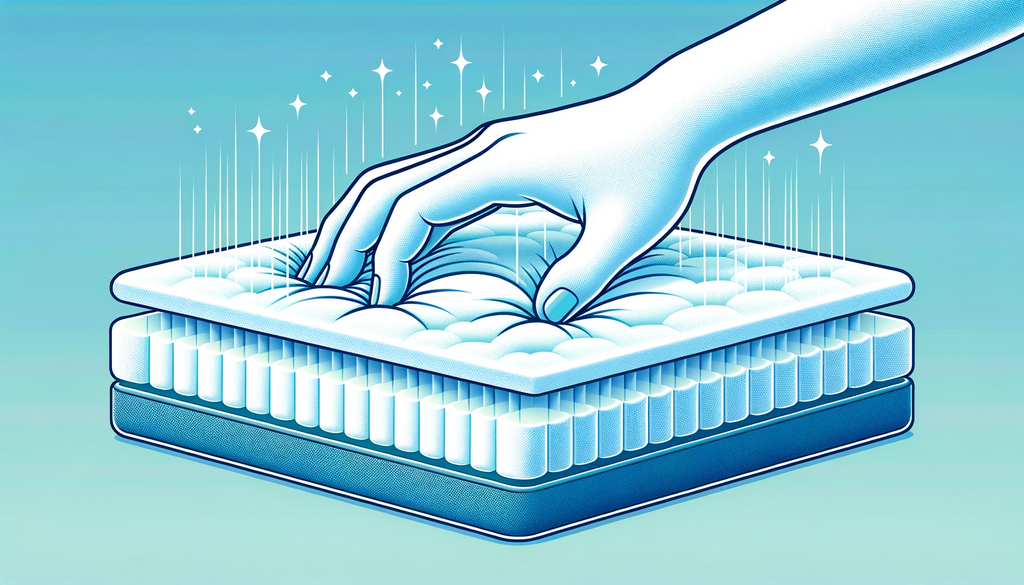
- The additional layer of comfort and protection.
- Different materials available for toppers and their benefits.
- How a custom topper can prolong the life of your mattress and offer added luxury.
Mattress toppers are more than just an add-on; they're a gateway to enhanced sleep quality. By acting as an extra cushioning layer, they provide immediate relief to sleepers, making even an old mattress feel renewed. Moreover, this layer is not just about comfort. A mattress topper serves as a protective shield against wear and tear, sweat, and potential allergen build-up, ensuring the longevity of the mattress underneath.
Different Materials Available for Toppers and Their Benefits
The market is flooded with various mattress topper materials, each bringing its unique set of advantages:
- Memory Foam: Adapts to your body shape, offering pressure relief and support. It's an ideal choice for those with chronic pain or sleep disturbances.
- Latex: Naturally hypoallergenic and anti-microbial, latex toppers are resilient and provide a bouncy feel that's neither too soft nor too firm.
- Feather & Down: Known for its luxurious feel, feather and down toppers provide plush softness and are incredibly breathable.
- Wool: A natural temperature regulator, wool toppers keep you warm in winters and cool in summers. Plus, they're resistant to dust mites and mould.
- Cotton: Breathable and soft, cotton toppers are often quilted for added comfort. They're also machine-washable, making them easy to maintain.
How a Custom Topper Can Prolong the Life of Your Mattress and Offer Added Luxury
Investing in a custom-sized mattress topper is not just about luxury; it's about smart economics. The topper takes on the brunt of daily wear and tear, safeguarding the mattress below. This protective layer can significantly extend the lifespan of your mattress, delaying the need for a replacement. Moreover, with the ability to choose the material and thickness of your topper, you can tailor your bed to match your specific comfort needs, ensuring a lavish and restful sleep night after night.
E. Sustainability in Materials
- The growing demand for organic cotton, natural latex, and eco-friendly foams.
- The benefits of opting for green materials, both for the sleeper and the environment.
- Certifications to look out for when choosing a sustainable mattress.
The Growing Demand for Organic Cotton, Natural Latex, and Eco-Friendly Foams
In an era where sustainability and eco-friendliness are more than just buzzwords, the bedding industry is experiencing a seismic shift towards greener materials. Consumers are becoming increasingly conscious of the products they bring into their homes, and mattresses are no exception. Organic cotton, cultivated without harmful pesticides and synthetic fertilizers, has become a sought-after fabric for mattress covers. Natural latex, tapped from rubber trees and processed without toxic chemicals, is favored for its resilience, comfort, and eco-friendly pedigree. Additionally, the rise of eco-friendly foams, made without ozone-depleting substances, reaffirms the industry's commitment to reducing its carbon footprint.
The Benefits of Opting for Green Materials, Both for the Sleeper and the Environment
Choosing a mattress made from sustainable materials is not just an act of environmental responsibility; it's a decision that can profoundly impact one's health and well-being:
- For the Sleeper: Organic and natural materials are hypoallergenic, reducing the risk of allergic reactions. They are also free from harmful chemicals, ensuring you aren't breathing in toxins as you sleep. Additionally, natural materials like latex are breathable, providing a cooler sleep environment.
- For the Environment: Sustainable farming and production practices reduce soil degradation, water wastage, and chemical runoff. Moreover, eco-friendly materials are often biodegradable, ensuring they don't contribute to landfill waste in the long run.
Certifications to Look Out For When Choosing a Sustainable Mattress
To navigate the green mattress market effectively, it's essential to be aware of certain certifications that vouch for a product's sustainability:
- Global Organic Textile Standard (GOTS): This certifies that the textile used, like organic cotton, meets the strictest environmental and social criteria.
- Global Organic Latex Standard (GOLS): A certification specifically for natural latex products, ensuring they are made from organic raw materials.
- CertiPUR-US: This certification ensures that the foam used in mattresses is free from ozone depleters, heavy metals, and other harmful substances.
- OEKO-TEX Standard 100: A global testing and certification system for textiles, guaranteeing they are free from harmful levels of more than 100 known substances harmful to human health.
By being informed and looking out for these certifications, consumers can make educated decisions, ensuring they invest in truly sustainable mattresses.
3. Delving into Custom Size Mattress Toppers
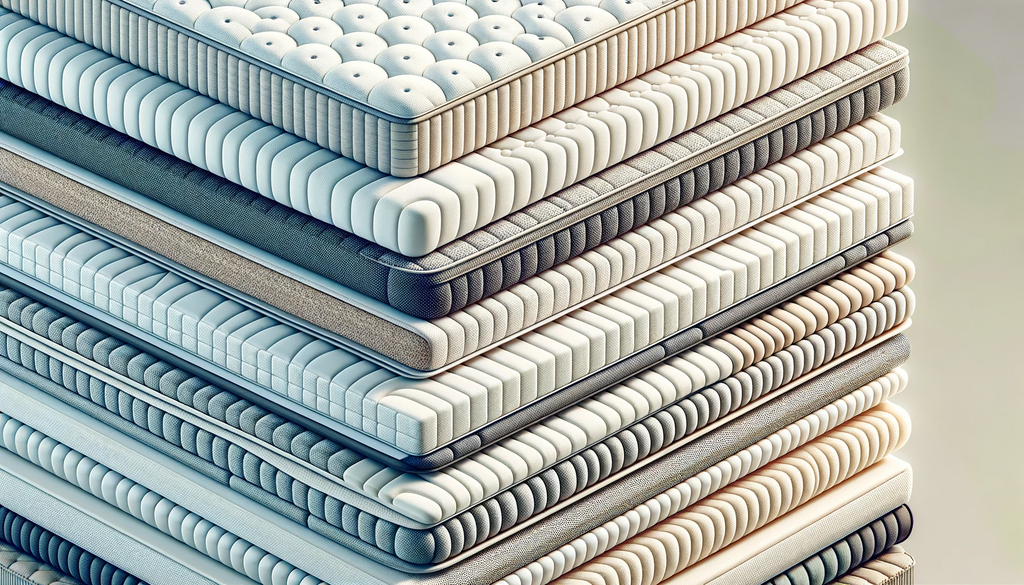
- Why you might need one.
- The added comfort and protective benefits.
A mattress topper is often the unsung hero in the world of bedding. It sits atop your mattress, providing that extra layer of cushioning and protection. But why might you need a custom size mattress topper? Let's explore.
Why You Might Need One
- Enhanced Comfort: Perhaps your current mattress is too firm, or you simply crave a plusher feel. A mattress topper can add that desired softness without the need to invest in an entirely new mattress.
- Lifespan Extension: Over time, even the best mattresses can show signs of wear and tear. A topper can help distribute weight more evenly, reducing the pressure on your mattress and prolonging its life.
- Specific Needs: Maybe you've recently had surgery, or you're experiencing body aches. A custom size topper tailored to your needs can provide targeted support, ensuring you sleep comfortably.
The Added Comfort and Protective Benefits
- Pressure Point Relief: A well-crafted topper can help in alleviating pressure points, ensuring you wake up without stiffness or pain.
- Temperature Regulation: Some toppers come with cooling technologies or materials that help in regulating sleep temperature, ensuring you're not too hot or too cold.
- Barrier Against Allergens: A topper can act as an additional layer between you and potential allergens or dust mites that might reside in your mattress.
- Spill and Stain Protection: Accidents happen. A topper can protect your underlying mattress from spills or stains, ensuring it remains in top condition for longer.
In conclusion, a custom size mattress topper is more than just an accessory. It's a tool for enhanced sleep, protection, and overall comfort. If you're seeking a simple solution to elevate your sleep experience, a bespoke mattress topper might just be the answer.
4. A Step-by-Step Guide to Ordering Your Custom Mattress in the UK
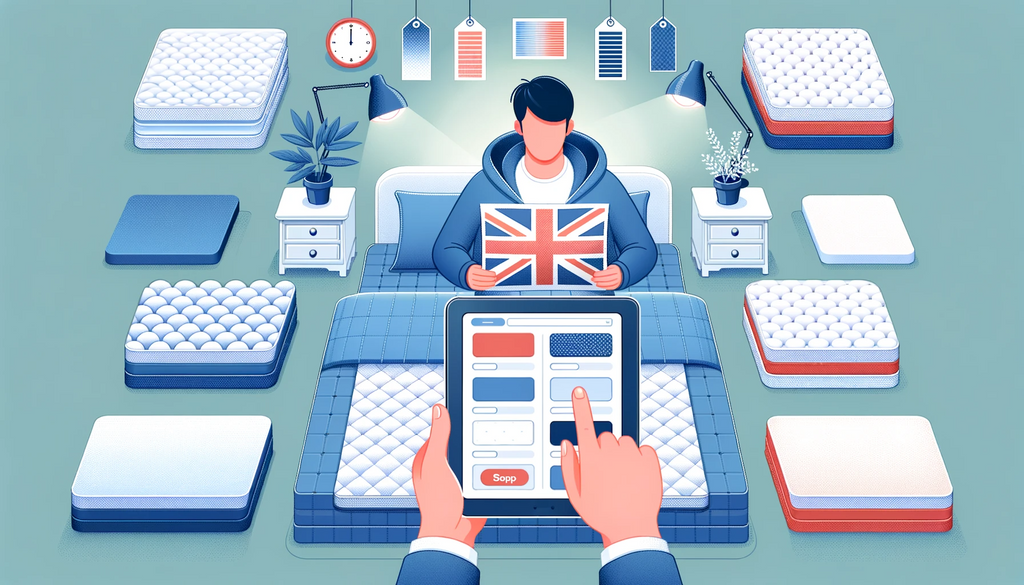
From measurements to material selection, this section will guide the reader through the steps of ordering their perfect mattress.
A. Taking Accurate Measurements
- The importance of precision.
- Tools and methods to ensure you get the right size.
- Common mistakes to avoid.
Every individual has unique sleeping preferences, and when it comes to custom size mattresses, ensuring that the measurements are accurate is paramount. A bed too large may not fit your space, while one too small may not provide the comfort you seek. Here's why precision is essential and how to achieve it:
The Importance of Precision
- Optimal Comfort: A mattress tailored to your exact measurements ensures you and your partner (if you share your bed) have ample space to sleep without feeling cramped or having limbs hanging off the edge.
- Space Utilization: Especially in urban settings where space can be a premium, a perfectly sized mattress can make all the difference in optimizing the layout of your bedroom.
- Aesthetic Appeal: A mattress that fits your bed frame perfectly, without gaps or overhangs, enhances the overall look and feel of your bedroom.
Tools and Methods to Ensure You Get the Right Size
- Measuring Tape: A simple yet essential tool. Ensure it's long enough to measure the full length and width of your sleeping area.
- Straight Edge: This aids in ensuring that your measurements are straight and not taken at an angle.
- Paper and Pencil: To jot down measurements as soon as you take them, so you don't forget or mix them up.
- Take Measurements Twice: It's always a good practice to measure twice to confirm your numbers.
- Enlist Help: For larger beds, having someone assist you can make the process smoother and more accurate.
Common Mistakes to Avoid
- Not Accounting for Bed Frame Dimensions: Remember, you're measuring for the mattress, not the entire bed frame. Ensure you're measuring the area the mattress will occupy.
- Forgetting Thickness: While length and width are essential, don't forget about the height, especially if you have specific bed linens or a particular bed frame in mind.
- Rounding Up or Down: Always stick to the exact measurements. Even a few centimeters can make a significant difference in fit and comfort.
By paying close attention to detail and ensuring accurate measurements, you're one step closer to getting the custom mattress that's perfect for your needs.
B. Choosing the Right Material
- Assessing personal needs: firmness, support, allergies, and more.
- The role of sleep trials and expert consultations.
Assessing Personal Needs: From Firmness to Allergies
Customizing a mattress goes beyond just getting the right size; it's about tailoring it to your unique needs and preferences to ensure the most restful night's sleep. Here's a comprehensive guide on what to consider:
Firmness & Support
- Know Your Preference: Everyone has a preferred sleeping surface, from soft and plush to firm and supportive. Understand what you like. Do you prefer a mattress that hugs you or one that offers more resistance?
- Sleeping Position Matters: Side sleepers might prefer a softer mattress that contours to their body, while back and stomach sleepers might opt for a firmer surface for better spinal alignment.
- Weight Considerations: Your body weight can influence how a mattress feels. Heavier individuals might find softer mattresses too sinking, while lighter individuals might find firm mattresses too hard.
Allergies & Sensitivities
- Hypoallergenic Materials: If you're prone to allergies, opt for hypoallergenic materials like latex or certain foams that repel dust mites and other allergens.
- Organic & Natural Options: These can be less likely to trigger allergies or sensitivities. Look for certifications like GOTS (Global Organic Textile Standard) or OEKO-TEX.
- Avoiding Chemical Off-Gassing: Some mattresses, especially certain memory foams, might emit a chemical smell when new. If you're sensitive to odors or chemicals, inquire about off-gassing and seek out low-VOC options.
Special Requirements
- Cooling Technologies: If you sleep hot, consider mattresses with cooling technologies or breathable materials like gel-infused memory foam or innerspring with good airflow.
- Motion Isolation: For those sharing a bed, a mattress that minimizes motion transfer ensures that one partner's movements don't disturb the other.
- Health Considerations: Issues like chronic back pain, arthritis, or other medical conditions can influence your choice. Memory foam, for instance, can be excellent for joint relief.
The Role of Sleep Trials & Expert Consultations
- Try Before You Buy: Many companies offer sleep trials where you can test a mattress for a certain period and return it if it's not suitable. This can be invaluable in finding the right fit.
- Leverage Expertise: Consult with mattress experts or customer service representatives. They can offer recommendations based on your preferences and needs.
- Visit Showrooms: If possible, visiting a showroom to feel different mattresses can give you a clearer idea of what you might like.
In conclusion, a mattress is a significant investment, not just in terms of money but also in terms of your health and well-being. Taking the time to assess your personal needs ensures that you get a mattress that serves you well for years to come.
C. Digital Customisation Tools
- The rise of online mattress configurators.
- How technology is making it easier to visualise and design your mattress.
The Digital Revolution: Online Mattress Configurators & Tech-Driven Design
In today's digital age, the way we shop for and design products has undergone a massive transformation. The mattress industry is no exception. Here, we delve into the rise of online mattress configurators and how technology is simplifying the customization process:
The Rise of Online Mattress Configurators
- Consumer Demand for Customization: The modern consumer seeks products tailored to their unique needs and preferences. Recognizing this, many mattress companies have introduced online configurators, allowing buyers to design their perfect mattress from the comfort of their homes.
- Interactive Experience: These configurators offer an interactive platform where users can select different layers, materials, and other features. As they make changes, they can immediately see the potential impact on comfort, support, and price.
- Educational Aspect: Configurators often come with detailed information about each material or feature, helping consumers make informed decisions. For instance, they might learn about the benefits of gel-infused memory foam versus traditional memory foam.
Technology's Role in Visualization and Design

- Augmented Reality (AR) & Virtual Reality (VR): Some brands have integrated AR and VR tools into their platforms, allowing users to virtually "place" the mattress in their room or even "lie down" on it virtually to get a feel of its comfort.
- 3D Modeling: Advanced 3D modeling tools can generate lifelike images of the mattress as users make changes, giving them a realistic view of the final product.
- Feedback Loops: Some configurators incorporate real-time feedback, where as users make choices, the system offers suggestions or highlights potential issues. For instance, choosing a very soft top layer with a firm base might trigger a suggestion to consider a medium-firm base for better compatibility.
- Integration with Smart Home Systems: With the growth of smart homes, some high-tech mattresses can now integrate with home automation systems. Configurators might offer options to add features like smart heating or sleep tracking.
In conclusion, the digitization of the mattress industry is not just a trend but a reflection of the broader shift towards personalization and convenience in consumer experiences. With advanced online tools and technology, designing the perfect mattress has never been easier or more exciting. The future promises even more innovations, making the mattress-buying journey seamless and tailored to individual needs.
D. Delivery and Setup

- What to expect when your custom mattress arrives.
- Tips for setting it up and ensuring its longevity.
Unboxing Your Dream: Setting Up and Caring for Your Custom Mattress
Welcoming a custom mattress into your home is an exciting event. It’s the culmination of your choices, preferences, and the promise of many nights of restful sleep. But as with all valuable investments, it's essential to know what to expect upon its arrival and how to care for it to ensure it serves you well for years to come. Here's a comprehensive guide:
What to Expect When Your Custom Mattress Arrives
- Packaging: Custom mattresses often come compressed and rolled in a box, especially if ordered online. This method, known as "Bed-in-a-Box," ensures the mattress remains in pristine condition during transit.
- Initial Expansion: Once unboxed, the mattress will start to expand. Depending on the materials used (e.g., memory foam), it might take a few hours to a couple of days for it to regain its full shape and size. It's recommended to allow this expansion in a well-ventilated room.
- Off-Gassing: Some mattresses may release a slight odor when first unpacked, a process known as off-gassing. This is typical, especially with memory foam mattresses, and the smell usually dissipates within a few days. Keeping the room ventilated can speed up this process.
- Visual Inspection: Check the mattress for any damages or inconsistencies. Ensure it matches the specifications you ordered, from the size to the selected materials and layers.
Tips for Setting Up and Ensuring Its Longevity
- Proper Foundation: A good mattress deserves a solid foundation. Ensure your bed frame or base is sturdy and offers ample support. For larger mattresses, ensure the frame has center support to prevent sagging.
- Mattress Protector: Consider using a mattress protector to shield your custom mattress from spills, allergens, and wear and tear. It's an affordable way to extend the lifespan of your mattress.
- Rotation: Rotate your mattress every 3-6 months to promote even wear. Note that some mattresses might be designed for one-sided use, so always check the manufacturer's recommendations.
- Clean Regularly: Vacuum your mattress every couple of months to remove dust and allergens. For stains, use a mild detergent and cold water, ensuring the mattress is thoroughly dried afterward.
- Avoid Jumping: As tempting as it might be for kids (or the kid in you), avoid jumping on the mattress. It can damage its structure and shorten its lifespan.
- Follow Care Instructions: Different materials may have specific care requirements. Always refer to the care instructions provided by the manufacturer.
In conclusion, receiving a custom mattress is just the beginning of your journey to improved sleep. By setting it up correctly and following essential care tips, you ensure that your mattress remains a comforting presence in your bedroom for the long haul. Sweet dreams!
5. Care Tips for Your Bespoke Mattress
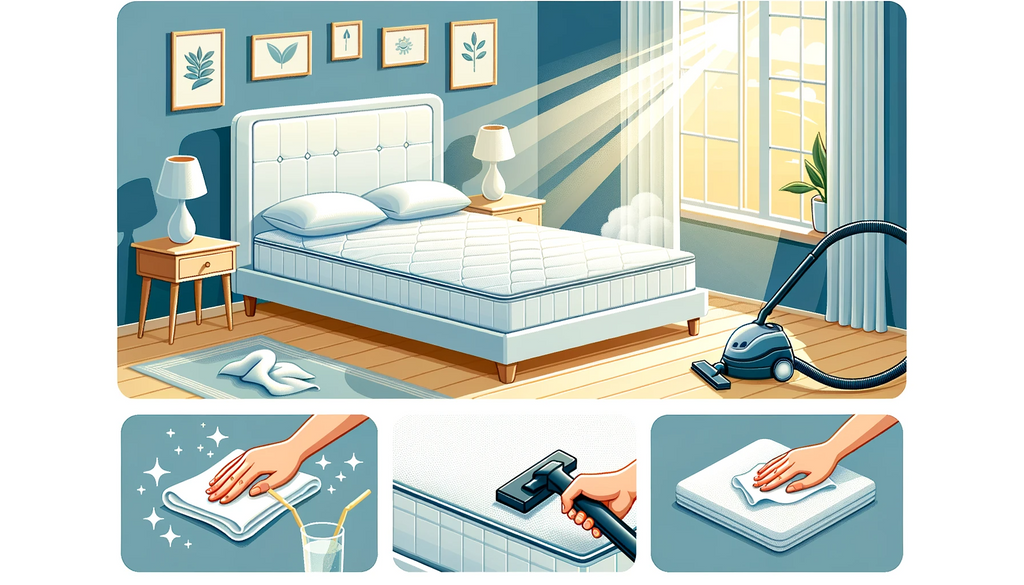
Ensuring that your bespoke mattress lasts for years involves more than just nightly use. This section will delve into maintenance, cleaning, and care.
A. Regular Rotation and Flipping
- The science behind mattress wear and how regular rotation can extend its life.
- How often should you rotate or flip, and why.
The Science Behind Mattress Wear
- Pressure Points: Our bodies aren't evenly distributed in weight. Areas like our shoulders, hips, and knees exert more pressure on the mattress. Over time, these pressure points can cause indentations and uneven wear.
- Heat and Moisture: Our bodies release moisture as we sleep, and we also generate heat. Both can affect the integrity of the mattress materials, especially memory foam, causing it to soften and break down faster in certain areas.
- Natural Materials Degradation: Mattresses made from natural materials, like latex or cotton, have inherent properties that make them break down over time. Exposure to body oils, moisture, and general use can accelerate this process.
The Role of Rotation in Extending Mattress Life
- Even Wear Distribution: Rotating the mattress ensures that wear is distributed more evenly across its surface. What was once the foot of your bed becomes the head, balancing out the pressure points and giving heavily used areas a break.
- Preventing Permanent Indentations: By changing the areas exposed to the most pressure, you reduce the risk of permanent indentations, ensuring a more even sleeping surface.
- Promoting Material Integrity: Rotation allows different parts of the mattress to 'breathe' and recover, especially crucial for materials like memory foam that can benefit from regular reshaping.
How Often Should You Rotate or Flip, and Why?
- Rotation Frequency: For most mattresses, especially those used regularly, a quarterly rotation (every 3-4 months) is ideal. This frequent rotation ensures even wear and reduces the risk of deep indentations.
- Flipping vs. Rotation: Some mattresses are double-sided and can be both rotated and flipped. Flipping a mattress changes the sleeping surface entirely, further ensuring even wear. However, many modern mattresses are designed for one-sided use. Always check the manufacturer's guidelines.
- Marking the Seasons: An easy way to remember to rotate or flip your mattress is to do it with the changing of the seasons. As you transition from winter to spring or summer to autumn, make mattress care a part of your home maintenance routine.
In conclusion, just as we rotate car tires or swap out shoes to ensure even wear, so should we care for our mattresses. Regular rotation, and flipping where appropriate, can significantly extend the life of your mattress, ensuring many more nights of comfortable, restful sleep.
B. Cleaning Tips and Tricks
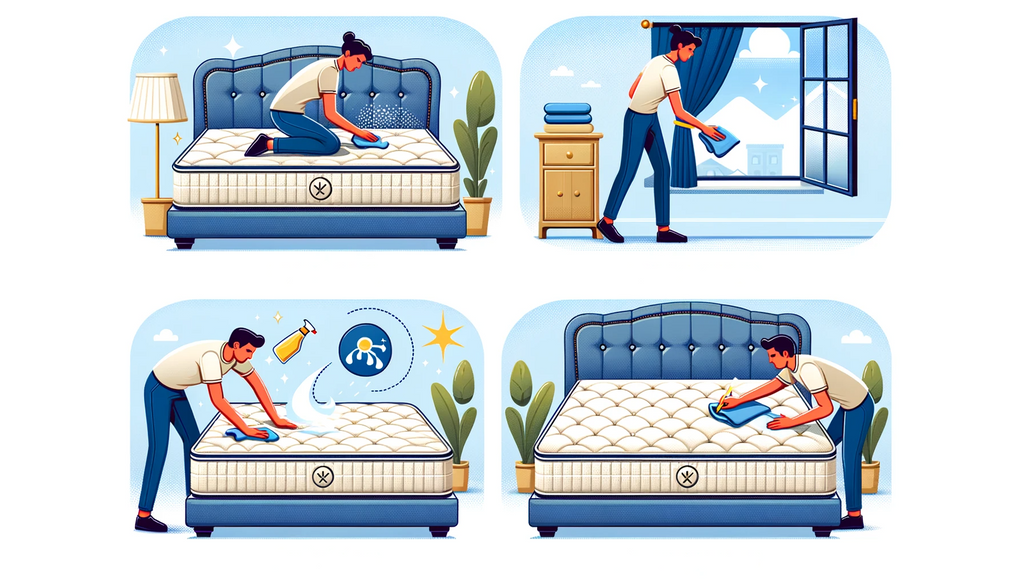
- Dealing with spills, stains, and odours.
- The role of mattress protectors and their benefits.
Our mattresses are more than just a sleeping surface; they're a sanctuary for relaxation and rejuvenation. However, maintaining them in pristine condition can be a challenge, especially with the occasional spill, stain, or mysterious odour. Here, we'll guide you through some effective cleaning methods and also introduce the protective shield of mattress protectors.
Dealing with Spills, Stains, and Odours
- Immediate Action: The key to handling spills is to act fast. Blot the spill with a clean cloth to absorb as much liquid as possible. Avoid rubbing, as this can push the spill deeper into the mattress.
- DIY Cleaning Solution: For most stains, a mixture of liquid dish soap, cold water, and a drop of vinegar can do wonders. Gently dab the solution on the stain and blot with a clean cloth.
- Odour Elimination: Baking soda is a natural deodoriser. Sprinkle a generous amount over the mattress, let it sit for a few hours, then vacuum it up. This can help neutralise odours and refresh your sleeping surface.
- Professional Cleaning: For persistent stains or odours, or at least once a year, consider a professional mattress cleaning. They use specialised equipment and solutions that can deeply clean and sanitise your mattress.
The Role of Mattress Protectors and Their Benefits
- Barrier Against Spills and Stains: A mattress protector acts as a shield, preventing liquids and spills from reaching the mattress. It's much easier to clean or replace a protector than a mattress.
- Allergy Prevention: Protectors also keep out dust mites, pet dander, and other allergens, providing a healthier sleeping environment, especially for allergy sufferers.
- Enhanced Lifespan: By guarding against wear and tear, moisture, and minor damages, protectors can prolong the life of your mattress, ensuring it remains supportive and comfortable for longer.
- Easy Maintenance: Many modern mattress protectors are machine-washable, making it convenient to maintain a clean and hygienic sleep environment.
In summary, a little knowledge and proactive care can go a long way in preserving the look and feel of your mattress. By addressing spills promptly, using gentle cleaning techniques, and investing in a quality mattress protector, you can ensure your bed remains a clean and inviting haven for years to come.
C. The Importance of a Good Base

- How the right bed frame or foundation can make a difference.
- Considerations for slatted bases, box springs, and adjustable bases.
How the Right Bed Frame or Foundation Can Make a Difference
Selecting the perfect mattress is just half the battle; choosing the right bed frame or foundation is equally crucial. The foundation you choose can have a profound impact on the comfort, support, and durability of your mattress, ensuring you get the best sleep possible.
- Enhanced Support: A sturdy foundation ensures that your mattress has the necessary support to prevent sagging and maintain its structural integrity over time.
- Improved Airflow: Elevating your mattress off the ground with the right foundation can promote better ventilation, reducing the risk of mold and dust mites.
- Optimal Spinal Alignment: The correct foundation can help maintain the mattress's shape, promoting optimal spinal alignment and reducing the risk of backaches.
Considerations for Slatted Bases, Box Springs, and Adjustable Bases
-
Slatted Bases:
- Supportive Design: Slatted bases offer a balanced support system, ensuring that the mattress doesn't sag over time.
- Breathability: The gaps between the slats allow for excellent airflow, helping regulate temperature and moisture levels.
- Spacing Matters: It's essential to ensure that the slats are spaced appropriately. Too much space between slats can compromise the mattress's support.
-
Box Springs:
- Shock Absorbency: Box springs are designed to absorb shocks, thereby reducing the wear and tear on your mattress and prolonging its lifespan.
- Elevation: A box spring can raise the mattress to a preferred height, making it easier to climb in and out of bed.
- Durability Check: Always ensure that the box spring is durable and free from any wear, as a compromised box spring can affect mattress performance.
-
Adjustable Bases:
- Personalized Comfort: Adjustable bases let you tweak your bed's angle, offering custom comfort for activities like reading, or to address specific health concerns.
- Therapeutic Benefits: Elevating certain parts of the body can assist with conditions such as swollen legs, acid reflux, or snoring.
- Compatibility: Before opting for an adjustable base, ensure that your mattress is designed to flex without causing damage.
In essence, the bed frame or foundation you select plays a pivotal role in determining the comfort and longevity of your mattress. Whether you're considering slatted bases, box springs, or adjustable bases, it's crucial to make an informed choice that aligns with your mattress type and personal preferences.
6. FAQs: Answering Your Burning Questions

Q1: How long does a custom mattress typically last? A1: The lifespan of a custom mattress varies based on its materials and usage. However, on average, a high-quality custom mattress can last between 7 to 10 years with proper care.
Q2: What should I consider when choosing the material for my bespoke mattress? A2: When selecting materials, consider factors like firmness preference, potential allergies, temperature regulation needs, and whether you're looking for eco-friendly options.
Q3: Are custom mattresses more expensive than standard ones? A3: While custom mattresses can sometimes be pricier due to their tailored specifications, many find the additional cost worthwhile for the unparalleled comfort and fit they offer.
Q4: Can I try out my custom mattress before finalizing my purchase? A4: Many bespoke mattress providers offer sleep trials, allowing you to test the mattress for a set period. This way, you can ensure it's the right fit before committing.
Q5: What kind of warranty comes with a made-to-measure mattress? A5: Warranty terms vary by manufacturer. However, most custom mattresses come with warranties ranging from 5 to 10 years, covering manufacturing defects and certain wear-and-tear issues.
7. Wrapping Up: The Comfort of a Perfectly Sized Bed
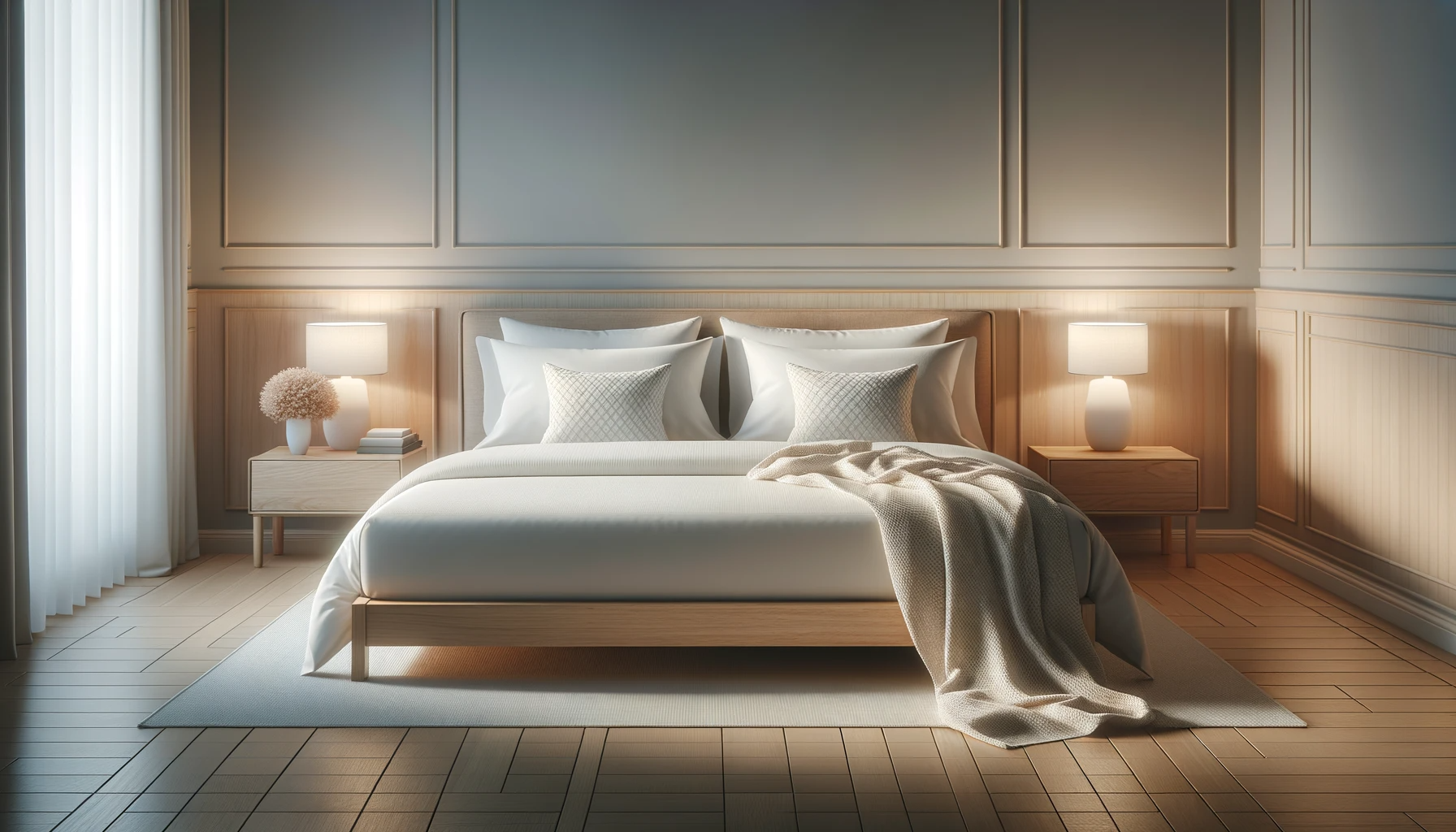
Choosing a mattress is more than just a purchase; it's an investment in your well-being. A bed tailored to your needs not only ensures restful nights but also positively impacts your overall health and quality of life. The peace of mind that comes with knowing you're resting on a mattress designed just for you is immeasurable.
Remember, it's not just about dimensions; it's about crafting a sleep experience that resonates with your unique needs. So, as you embark on your journey to find the perfectly sized bed, take solace in the fact that the ultimate comfort of a bespoke mattress awaits you.